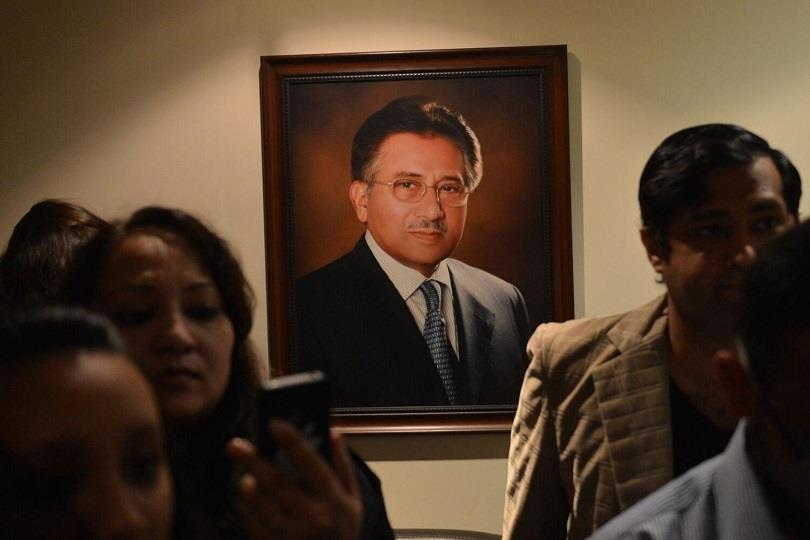(MENAFN- Kashmir Observer) A portrait of Pervez Musharraf. Photo: AFP
Former Pakistan president's passing, in a sense, is symbolic of the new reality. Not only has Kashmir issue he painstakingly tried to resolve drastically altered in its complexion, but J&K as a geographical entity has also transformed
THE passing away of former Pakistan president General Parvez Musharraf couldn't have come at a more telling moment in Kashmir's history: not only is there no engagement between India and Pakistan but New Delhi has also decisively taken Kashmir off the table from any discussions with Islamabad – the 75 year old issue that Musharraf came closest to resolving during his tenure. If lawyers' agitation hadn't happened, which eventually forced his ouster, India and Pakistan may have reached a breakthrough over the issue. And who knows the relations between the two countries might have entered a happily ever after state.
Musharraf's settlement blueprint popularly known as Four Point Formula had set out a four stage incremental process for Kashmir resolution. The steps were: identification of the regions in Kashmir for solution, demilitarization, self governance and a joint management or a consultative mechanism between India and Pakistan on the then state.
It was actually the former Prime Minister Atal Bihari Vajpayee who had begun the promising negotiations with Musharraf, his then Pakistani counterpart, which were later followed up by the former Prime Minister Manmohan Singh. The process had nearly culminated in a Kashmir solution by the end of 2007 when Musharraf's sudden loss of power as a result of the then lawyers' agitation and the subsequent Mumbai attacks aborted it.
However, a lot has happened since then. The dynamics that made the engagement possible at the time no longer exist. Several new factors are at play in the regional geo-politics and in the relations between the two countries that have made it increasingly difficult to go back to the formula.
The biggest change that has since taken place is the withdrawal of Article 370, which granted J&K its semi-autonomous position within the Indian Union, and the splitting of the former state into two union territories. This, from New Delhi's point of view, has more or less ended Kashmir as an issue between India and Pakistan. India has now changed its goalpost. It seeks return of the part of Kashmir under the jurisdiction of Pakistan. And it is loathe to even resume dialogue with Islamabad except on its own terms. And Pakistan's response to this so far shows that the country is in no position to challenge India's altered position on Kashmir. While Islamabad may not have reconciled to the constitutional changes in region it claims, the country has now kind of gotten used to the new state of affairs in the region.
So Musharraf's death, in a sense, is symbolic of the new state of affairs. Not only has Kashmir issue as we understood it drastically altered in its complexion, but J&K as a geographical entity has also transformed: It is no longer a state but divided into two union territories. And the once vaunted separatist conglomerate Hurriyat Conference has become extinct. Many of the grouping's top leaders continue to be in jail or are under house arrest. This has hobbled its capacity to organize any political activity.
But even if the separatist leaders were free – and some of them are free – the situation would hardly be different. The government has outlawed any sign of separatist activity in whatever form and disproportionately raised the cost for any leader or an activist to go out and champion the cause.
It is now difficult to believe that during Musharraf's term, when the peace process between India and Pakistan was in full gear, billboards featuring his and Manmohan Singh's images were up all around Srinagar. Then it was seen as the right thing to do. Musharraf had made a dedicated effort to seek a lasting peace with India by finding what he then fondly called“out-of-box solution” to Kashmir. He sought to achieve this through unilateral flexibility – subsequently reciprocated by New Delhi – only to end up nowhere.
In his term, Musharraf also presided over a progressive decline in the militancy, an ironic about-turn from the architect of Kargil war. The militant killings went from 961 in 2004 to just 100 in 2013. What is more, it was Musharraf who first instituted the ceasefire along the Line of Control in 2002. And it was this truce that India and Pakistan re-affirmed in February 2021. In a sense, one feature of the current uneasy calm between the two neighbours harks back to Musharraf era.
But in all other features, we have moved on from Musharraf's time. Since then, Pakistan has become a weaker country and has also lost much of its bargaining power on Kashmir. And going by the words of its prime minister Shahbaz Sharif, last year the country was bargaining for a plan to freeze the Kashmir issue for 20 years, reportedly in lieu of trade with India.
Views expressed in the article are the author's own and do not necessarily represent the editorial stance of Kashmir Observer
The author is the Political Editor at Kashmir Observer
follow this link to join our whatsapp group : join now

















Comments
No comment